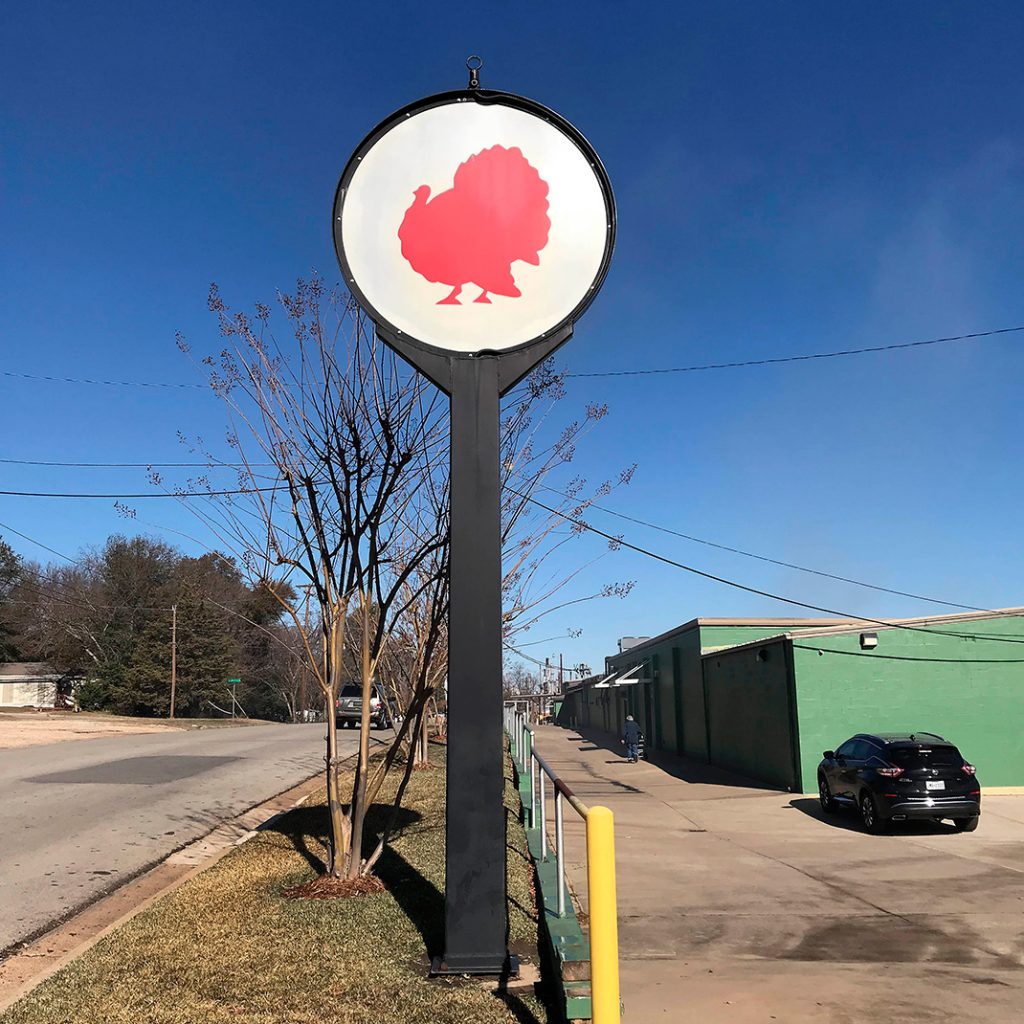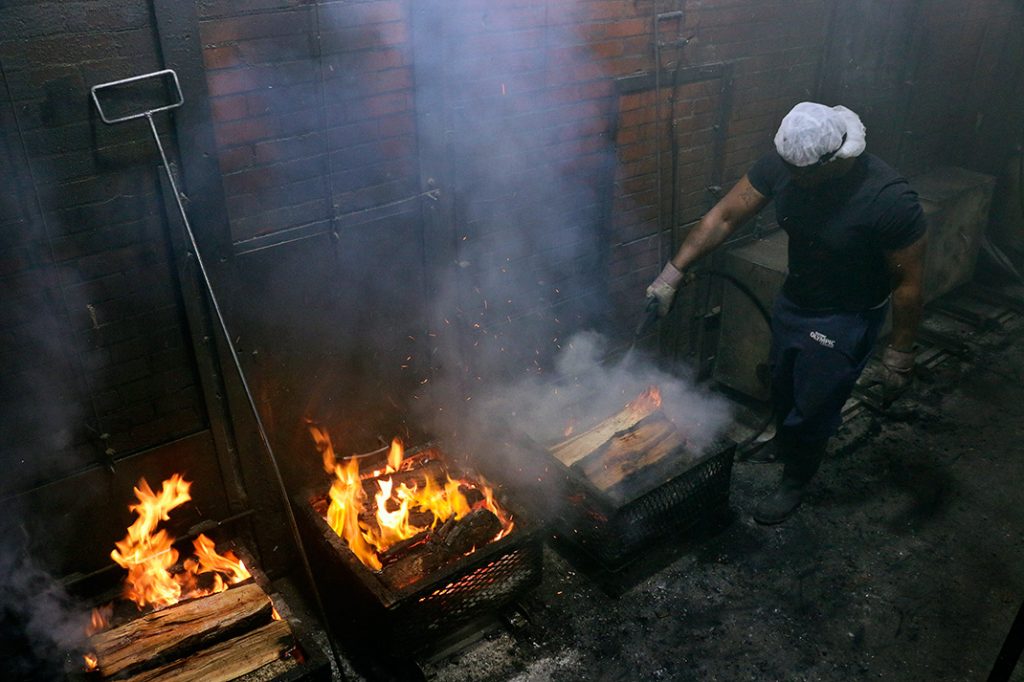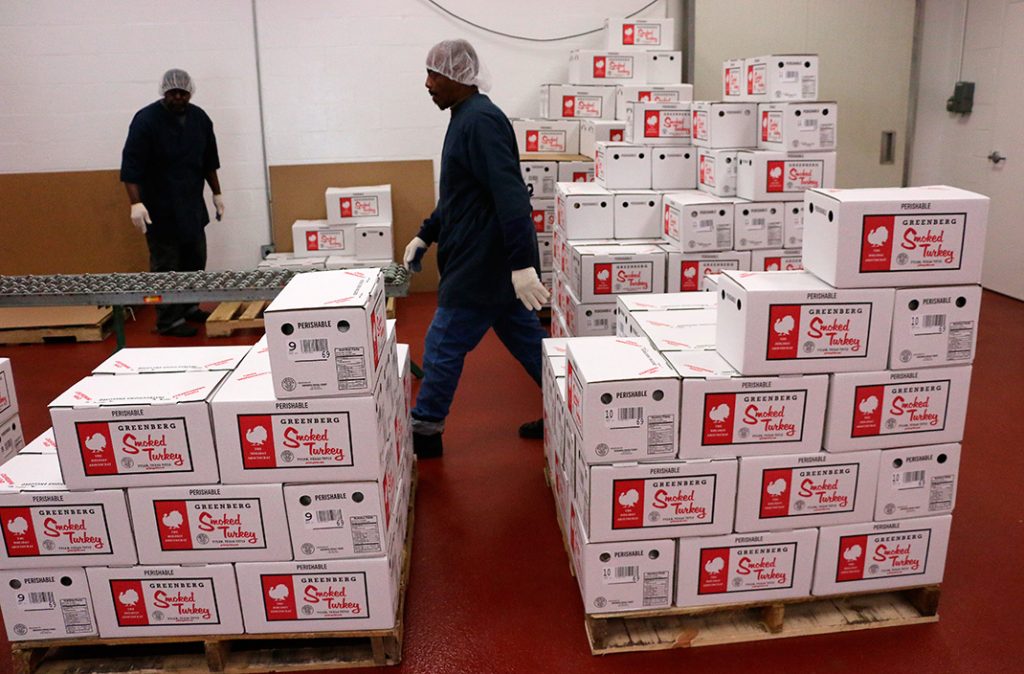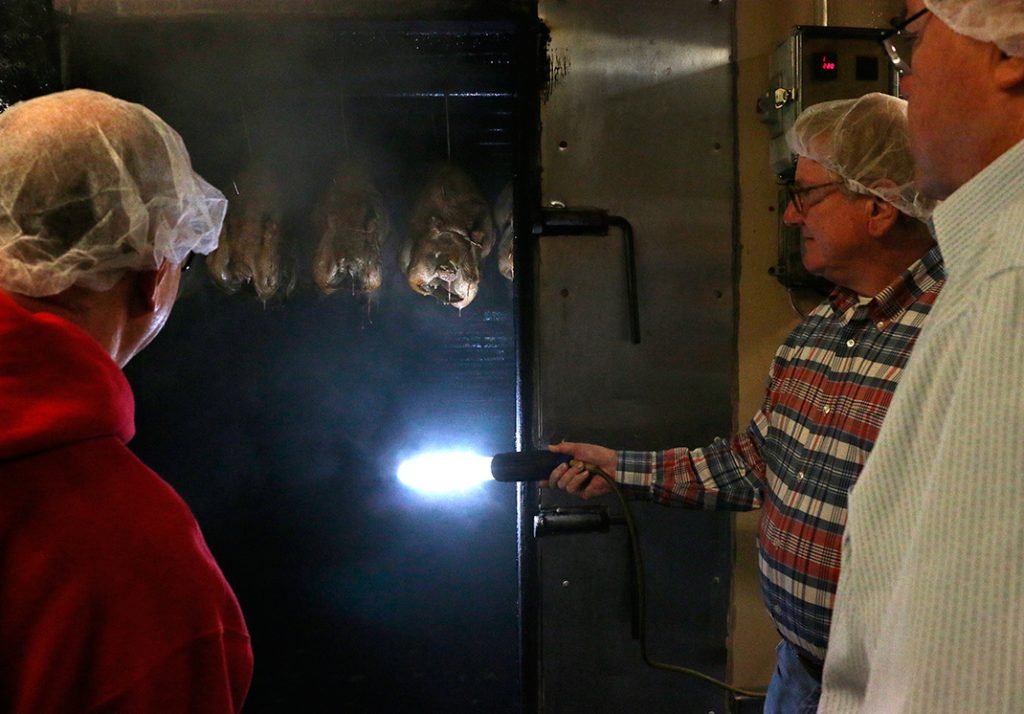
A simple sign displaying a turkey marks Greenberg Smoked Turkey offices in Tyler. (Photo ©Chris Wilkins/Texas BBQ Posse)
TYLER, Texas – As a Greenberg Smoked Turkey rolls off the production line – hickory-cured to its distinctive mahogany hue, sealed in plastic, then packed into its distinctive white box with red and black lettering – it passes beneath a small mechanical press. The press drives two copper-colored staples into the box, to seal it.
That stapler is the first and only machine you’ll find on Greenberg’s production line.
Up to that point, every step in creating this world-famous delicacy – “The Holiday Aristocrat,” as its slogan proclaims -- is performed by human hands.
“It’s done exactly the same way my grandfather did it,” says Sam Greenberg, the company’s third-generation owner.
First sold in Tyler in the 1930s, Greenberg Smoked Turkeys have become a cherished holiday tradition for families throughout the Southwest and well beyond. There are loyalists who wouldn’t put anything else on their Thanksgiving or Christmas table. They swear by the meat’s deep, rich and unmistakable flavor. (However, a writer from Fast Company, a New York business magazine, found the intense aroma of a Greenberg turkey less than intoxicating. When you open the box, he wrote, the smell is “like something that had been dragged, not quite in the nick of time, from a tragic house fire.”)
Most Texans – certainly, most barbecue aficionados – have heard of Greenberg Smoked Turkeys. But few know what goes into making a Greenberg so special. Fewer still, I would guess, know how a Jewish family in Tyler, Texas, of all places, created a business empire by selling, of all things, smoked turkeys.
In pursuit of the answers (and always eager to sample an expertly smoked meat), the Texas BBQ Posse rode east to Tyler, where Sam Greenberg gave us a personal tour of his place, then spent the better part of the morning talking turkey with us.
Our trip was organized, as usual, by Posse co-founder Chris Wilkins, a Tyler native who’s been enjoying Greenberg turkeys since he was a sprout. As long as we were in the neighborhood, Chris made sure we also made time to visit two of his favorite Tyler barbecue joints, Stanley’s and Pat Gee's.
Also on the trip were Posse pitmaster Marshall Cooper; and the present author, known to some readers as “Where’s Gary Jacobson?”
We learned how Sam Greenberg, with 14 full-time employees and a seasonal workforce of about 200, manages to turn out 200,000 exquisitely smoked turkeys in just three months leading up to Christmas.
And we learned much more about “The Holiday Aristocrat.”

A pitmaster sprays water to cool down one of 60 pit fires at the Greenberg Smoked Turkey plant. (Photo ©Chris Wilkins/Texas BBQ Posse)
How the turkeys are prepared
Customers can order Greenberg turkeys year-round, but the vast majority are sold around Thanksgiving and Christmas. Because of that, the serious smoking gets under way near the end of September. It ends on Christmas Eve, when Sam shuts the operation down.
“After Christmas, we usually wind up with 1,500 to 5,000 turkeys left over,” he says. That inventory, once frozen, will cover off-season orders well into the next year. (Regardless of when they’re smoked and when they’re ordered, all Greenberg turkeys are frozen before shipping. Only in Tyler can walk-up customers buy one fresh out of the smoker.)
Greenberg buys its raw turkeys frozen. Sam says they’re no different from what you’d find at your local supermarket.
After thawing in water overnight, each turkey is trimmed -- by hand. A cutter removes the wing tips, along with any excess flaps of skin. “I’m not going to make our customers pay for waste,” Sam explains.
Each bird is washed, inside and out, by hand. A second cutter then makes slits in the breast and drumsticks and under the skin near the cavity opening – by hand -- so the next worker on the line can pack those slits with Greenberg’s custom rub – by hand.

Turkeys are trimmed by hand by a team of Greenberg employees. (Photo ©Chris Wilkins/Texas BBQ Posse)
After resting overnight, the seasoned turkeys are hung from hooks in the plant’s 20 large smoking chambers, each of which holds 100 birds. They cook at roughly 220 degrees for roughly 16 hours. (“They’re done when they’re done,” Sam says.)
The smokers burn hickory – not a gasser in sight – and they burn a lot of it, a cord a day. The wood fires – three per smoker, or 60 in all, of course must be tended to by hand.
The design of the smokers, like many things in the plant, is a Greenberg family innovation. As Posse members, we’ve seen our share of pits, and none of us has seen a setup like this one.
The floors of the smokers are made of a metal grating. The fireboxes, large metal crates that get filled with glowing logs, are one level below the floors. Once they’re positioned under the smoking chambers, their hickory smoke rises through the holes in the grating, slowly cooking the hanging turkeys.
The fireboxes have wheels. They’re mounted on metal rails that run the length of the smoking chamber. Using long hooks (and heavy leather gloves), the pit crews can pull the boxes out along the rails to add wood or tamp down the flames. The rail system also allows the fires to be moved around under the racks of birds, to ensure uniform cooking temperatures and smoke levels.
When the turkeys are done, they’re transferred to a cooling room, then sealed individually in plastic bags and boxed according to weight – once again, all by hand. The boxed turkeys are stacked in one of five freezer buildings to await shipment.

Hundreds of Greenberg smoked turkeys await packaging in a huge walking cooler room. (Photo ©Chris Wilkins/Texas BBQ Posse)
If the system works, don't mess with it
From the time a raw turkey is unfrozen to the time it’s smoked and ready to ship, it loses nearly half its weight. That’s an inordinately high weight loss, a result of Greenberg’s hand-trimming and smoking methods. Since the turkeys are sold by the pound, lost weight means lost money.
There are ways to reduce the shrinkage. Sam could, for example, stop cutting off the wings. They’d be shriveled, burned, and inedible by the time the turkeys came out of the smoker, but most customers would neither notice nor care they were paying for this extra bit of weight.
Sam would notice, though. To him, changing anything about his production process would mean he was tampering with the way the Greenbergs have smoked turkeys in Tyler for more than 80 years. That's not happening.
“I resist change at all costs,” he says. “What we’re doing works. It’s worked for a very long time. Why mess with it?”
“I’m not gonna blow it by looking for ways to save a dollar. And I’m not gonna be the guy who creates the next New Coke.”
Besides, he maintains, Greenberg’s costly, labor-intensive methods, seemingly a drain on revenues, actually give the company a competitive edge.
“No one else smokes turkeys this way,” Sam says. “The human labor we put into it is crazy by industry standards. As a result, the barriers to entry that we’ve created are way too high for most competitors.
“There just can’t be too many of me running around out there.”

Boxed turkeys are stacked for shipping at the Greenberg Smoked Turkey plant. (Photo ©Chris Wilkins/Texas BBQ Posse)
Humble beginnings for a turkey dynasty
Greenberg Smoked Turkeys was founded by Sam’s grandfather, Samuel Isaac Greenberg, a Polish immigrant who landed at Galveston in 1903, at the age of 17. He made his way north to Tyler, where he established a modest dairy farm.
Back in Poland, his mother had passed down the Greenberg family recipe for smoking birds. And Samuel had been certified as a shochet, someone authorized under Jewish tradition to slaughter animals for food in accordance with kosher law.
He built a makeshift smokehouse at his dairy and, using mom’s recipe, he began smoking ducks, chickens, and turkeys over hickory fires. The birds were tasty. As word of the young shochet’s pit skills spread, his Jewish neighbors, when they delivered animals for slaughter, started asking Samuel to smoke the meat as well.
By the 1930s, Samuel Greenberg was augmenting the earnings of his dairy by selling kosher smoked turkeys to Tyler’s Jews and non-Jews alike.
The sideline started evolving into a career change some time around 1939. (Published accounts disagree on the exact year.) A would-be customer in Dallas wanted six smoked turkeys, but Samuel had no way to deliver them 100 miles away.

Pitmasters tend hickory fires at the Greenberg Smoked Turkey facility. (Photo ©Chris Wilkins/Texas BBQ Posse)
His son Zelick (the father of the current Sam Greenberg) came up with a plan. He took the turkeys to a candy shop in Tyler, which packed them into large boxes lined with straw for padding. Zelick put the boxes on a train bound for Dallas.
The out-of-town orders kept coming, as more and more people got their first taste of a Greenberg turkey. To meet the swelling demand, Samuel and Zelick built five additional smokehouses at the dairy.
A Christmas Eve fire in 1948 destroyed the smokehouses, but not the turkey business. The Greenbergs rebuilt their smokers, bigger than before. The current plant is an amalgamation of bland industrial buildings sheathed in cinder block or sheet metal. Some were put up right after the Christmas Eve fire. Some are later additions. Today, Greenberg Smoked Turkeys covers the land that was once the family dairy.
First-time visitors usually figure out they’ve arrived from the strong aroma of burning hickory. The smoke is easier to notice than the one sign outside the facility, a red silhouette of a turkey on a round white background mounted atop a pole.
Zelick, who succeeded his father as head of the company, is generally credited with building Greenberg Smoked Turkeys into a lucrative business and signature brand. He died of a heart attack in 1996 at the age of 83.
Sam says there was never much doubt about his own career path. “I can’t remember a time when I wasn’t working here,” he says. “It never occurred to me when I was growing up that I would do anything else.
“This business was built by our family. In a sense, it is our family. I’m just the latest caretaker.”

Greenberg Smoked Turkeys owner Sam Greenberg poses for a portrait. (Photo ©Chris Wilkins/Texas BBQ Posse)
Sam is the man at Greenberg
In blue jeans and a plaid shirt, Sam, a ruddy-faced, sandy-haired 59-year-old, hardly looks the part of a corporate CEO running a multimillion-dollar enterprise. He doesn’t act like one, either. He’s plainspoken, self-effacing, unfailingly cheerful, and cordial to all. There’s not a pretentious bone in his body. He likes Frito pie, sandwiches on white bread, and cold beer.
But make no mistake: The boss at Greenberg Smoked Turkeys is one smart bird.
The smoking process hasn’t changed in generations, but running a family business has. Sam, who has a business degree from the University of Texas, is, in his way, a shrewd – and modern -- executive.
He has a knack for promotion and marketing. Whenever journalists visit, Sam tries to greet them himself and show them around. He’s gracious, witty, and generous with his time. Invariably, the journalists – many from prestigious national publications – depart believing that in Greenberg Smoked Turkeys, they’ve seen a special place. It’s a warm sentiment that’s reflected in a stack of press clippings that are uniformly positive, if not downright gushy.
A few years ago, the Greenberg brand, already sterling, got a further burnishing when Sam signed a deal with Central Market, giving the foodie wonderland exclusive rights to sell his turkeys in its stores. And just last month, he struck free-PR gold: Oprah chose Greenberg Smoked Turkeys as one of the items on her immensely popular “list of favorite things” for 2017.
Props from Oprah are all well and good, but Sam knows that word of mouth remains his company’s most effective form of advertising, and he’s fanatical about keeping his customers happy. After a lifetime of selling Greenberg turkeys, he knows what people expect when they buy one, and he does his best never to disappoint. He won’t sell a turkey that he wouldn’t gladly buy himself, and he won’t charge a price that he would find excessive – even when the cost of raw poultry rises, cutting into his margins. (Currently on the company’s website, turkeys are priced around $5.50 a pound, plus delivery charges. The exact price depends on the size of the bird.)
Sam has resisted the temptation, common among those who make it big in the specialty food business, to branch out and expand his product line. (In his case, it’s more of a product dot. Greenberg smokes turkeys. Period.) As long as he’s in charge, you won’t find the Greenberg label on instant stuffing mix or jars of giblet gravy or backyard smokers or cookbooks or carving knives.
The company did try smoking hams in the late 1970s, he said. The experiment was abandoned because of difficulties with quality control. You can look into the cavity of a turkey to make sure nothing funky is going on in there. You can’t do the same with a ham.

Turkeys are packed at the Greenberg Smoked Turkey facility. (Photo ©Chris Wilkins/Texas BBQ Posse)
Gobblegobble.com
Bacterial contamination is always a risk when people work around raw poultry. To avoid outbreaks, Sam has installed a chemical sanitizing system. He says it’s like the ones used in hospital emergency rooms.
Before entering the smoker building, anyone coming from the work area where uncooked turkeys are prepped must first plunge both arms elbow-deep into an antibacterial bath. The chemical wash keeps killing germs on the hands for 24 hours.
If Sam hasn’t quite embraced the digital age, he’s at least learned to live in it. He’s enough of a pragmatist to understand the vital role that technology plays in 21st century commerce. With the help of a nephew he calls a computer genius, Sam has turned to the Internet and to state-of-the-industry software to streamline Greenberg’s order-taking, logistics and shipping operations.
All of his turkeys are delivered by UPS Ground Service. Usually, the white Greenberg box shows up on the customer’s doorstep within two or three days of an order being placed.
These days, about 40 percent of sales are online. (The company’s website is gobblegobble.com.) Most of the rest come by phone (903-595-0725). As the holidays draw near, it takes a bank of up to 30 operators, each seated before a large computer monitor, to process the telephone orders.
The sales setup is a far, far cry from what was in place before Greenberg started accepting credit cards in 2010. Until then, all sales were on an honor system: Customers weren’t asked to pay until they received their shipped turkey, which came with an invoice enclosed. Then, and only then, they’d send in a check.
“Did a lot of people stiff you?” we asked.
“Not if they ever wanted another turkey,” Sam replied.

Sam Greenberg shows Bruce Tomaso, left, and Marshall Cooper the inside of one of 20 smoker rooms at the Greenberg Smoked Turkey plant. (Photo ©Chris Wilkins/Texas BBQ Posse)
The real secret of a Greenberg smoked turkey
When it comes to guarding the family’s cooking secrets, Sam is sharp as a hawk.
When we arrived and introduced Marshall as the Posse’s pitmaster, Sam shot him a wary glance – more of a glare, actually. It was a look like the one a bank manager might give to a stranger who walked in and asked to open an account under the name “C. Barrow.”
Everything was fine as soon as we explained that Marshall isn’t in the restaurant business. Barbecue is his love, not his livelihood. He wasn’t a competitor, and he wasn’t there to spy.
Minutes later, during our tour, I was on the receiving end of that same wary eye when Sam caught me trying to read the ingredients on a box of Greenberg’s custom rub. Again, we assured him there was no cause for worry -- I was just being a thorough reporter. And in any case, the box label was useless. It listed the rub’s ingredients as “salt, spices, flavoring.”
None of that mattered anyway, Sam later told us. The real secret to a Greenberg Smoked Turkey – the one no one will ever figure out or replicate – involves the way his huge smokers draft. He keeps the airflow design, another Greenberg innovation, where he knows it’s safe: In his head.
“I showed you where the smoke comes from,” he said, referring to the subfloor system of fireboxes on rails.
“I didn’t show you where it goes.”
When the pits were built, he said, each contractor – the metal-flooring man, the concrete man, the hardware man – was only told what he needed to know to finish his part of the job. No one got a look at a full set of plans.
Even Sam’s insurance carrier, out to inspect the property, was warned not to poke his nose where it didn’t belong. “Those pits haven’t caught fire in 70 years,” Sam told the insurance guy. “They’re not going to catch fire now. You don’t need to look inside.”
Our tour yielded no clue. To keep us from getting a good look into the smokers, Sam used a smokescreen – literally. As soon as he opened the door to a smoker, a thick, vast gust of white-gray hickory smoke came rolling out.
The smoke was so dense that a searchlight couldn’t have pierced it. As it enveloped us, Chris, Marshall and I started coughing like we’d been tear-gassed.
When we looked into the smoker – once our eyes stopped watering – we could make out a few of the turkeys hanging closest to the door. That was it.
I’m fine with that. As long as Greenberg Smoked Turkeys keep coming out like they do, I don’t care how they get there.

Smoked turkeys hang on a rack ready for packing. (Photo ©Chris Wilkins/Texas BBQ Posse)
NOTE: In the interest of full disclosure, I should mention that as we were leaving Greenberg Smoked Turkeys, Sam Greenberg gave each of us a gift – a 10-pound smoked bird, fresh off the production line.
“Thanks, but you don’t have to do that,” Chris said.
“I know,” Sam replied. “I didn’t have to talk to you for two hours, either. I did it because I wanted to.”
We thanked him and loaded the turkeys into our SUV.
I mention this because traditional news organizations – concerned, I supposed, that journalists can be bought cheaply – have policies prohibiting staff members from accepting gifts with more than a token value. A pencil would be OK. A Montblanc fountain pen would not.
While many of us in the Posse were career journalists, we’ve nearly all moved on. Still, the ethics code that governed my professional conduct for more than 30 years left its impression, I guess. So bear with me while I address the matter of the freebie turkeys.
1. The Texas BBQ Posse isn’t a news organization. We have policies – don’t fill up on sides, always order brisket from the fatty end, look for the wood pile, always walk around back to check out the smoker, never eat barbecue from an airport food court – but as far as I know, we don’t have a policy on free turkeys.
2. Those of us who contribute to this blog aren’t employees – at least, we’re not paid employees. We can’t be fired, and if we could, we’d probably just keep showing up anyway.
3. With or without the turkey, I have nothing bad to say about Sam Greenberg or his company. I took his gesture to be a kind one. (And the turkey was delicious.)
4. I can’t speak for others, but I’m offended at the notion that I could be bought off with a $60 smoked turkey. I have principles. My price is three turkeys. And make them 12-pounders, please.







